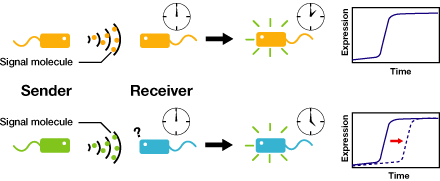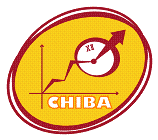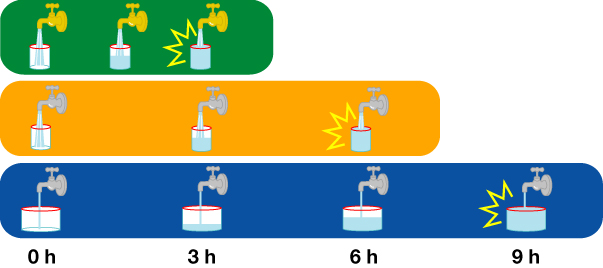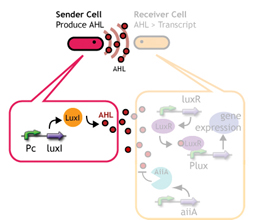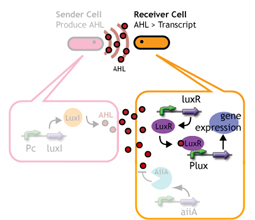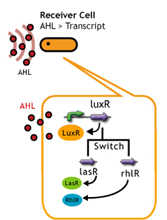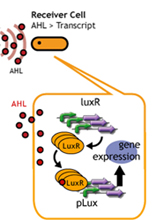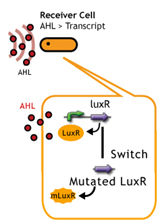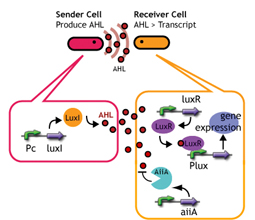Team:Chiba/Project
From 2008.igem.org
(→Future Work) |
(→System design) |
||
| Line 61: | Line 61: | ||
[[Team:Chiba/about_qs|クオラムセンシング]]を利用する。 | [[Team:Chiba/about_qs|クオラムセンシング]]を利用する。 | ||
| + | |||
| + | われわれが使うクオラムセンシングではシグナル分子であるAHLは、生物によって形が違うものが使われている。 | ||
| + | |||
| + | |||
シグナル分子を蓄積していく->ある点(応答閾値)まで蓄積すると、遺伝子発現が起こる | シグナル分子を蓄積していく->ある点(応答閾値)まで蓄積すると、遺伝子発現が起こる | ||
遺伝子発現が起こる応答閾値に達するまでの時間を変えることが目的 | 遺伝子発現が起こる応答閾値に達するまでの時間を変えることが目的 | ||
| + | |||
2、どうやって? | 2、どうやって? | ||
| + | |||
| + | 応答閾値を変える方法はいくつか考えられる | ||
・合成するシグナルを変える | ・合成するシグナルを変える | ||
| Line 78: | Line 85: | ||
| - | + | ==Experiments and Result== | |
===Signal Molecule Sender === | ===Signal Molecule Sender === | ||
[[Image:Chiba project design Sender.jpg|left]] | [[Image:Chiba project design Sender.jpg|left]] | ||
Revision as of 14:56, 27 October 2008
| Home | The Team | The Project | Parts Submitted to the Registry | Reference | Notebook | Acknowledgements |
|---|
Abstract
- "Team : Chiba - E.coli time manager"
We control the timing of gene expression by using multiple signaling devices.To this end,we utilize molecules associated with Quorum sensing, a phenomenon that allows bacteria to communicate with each other.Our project uses two classes of bacteria: senders and receivers. Senders produce signaling molecules, and Receivers are activated only after a particular concentration of this molecule is reached.Although different quorum sensing species have slightly different signaling molecules, these molecules are not completely specific to their hosts and cross-species reactivity is observed [http://www3.interscience.wiley.com/journal/119124142/abstract (1)],[http://partsregistry.org/Part:BBa_F2620:Specificity (2)]. Communication using non-endogenous molecules is less sensitive, and requires a higher signal concentration to take effect.This results in slower activation of receivers.
Introduction
Our project
従来:消えていく物質の存在時間によって時間調節する。Missouri Miners 2007 "A biological timer"
千葉:常に物質が一定の割合で蓄積されるとき、ある閾値超えるまでの時間調節する。
調節する方法には、二つが挙げられる。
- 蓄積するときの割合を変える。
- 閾値自体を変える。
- 右の絵は一定の割合で水がある容器の中にたまっていく様子を示している。
- ここでは、容器に水がたまることった時が閾値を超えた時とする
- 一番上は蓄積するスピードが速く、容器が小さいのでたまる時間は短い
- 真ん中は蓄積するスピードは速いが、容器が大きいためにたまる時間は遅くなる
- 一番下は蓄積するスピードが遅く、容器が大きいためにたまる時間がより遅くなる
System design
1、全体の説明
蓄積したシグナル分子によって遺伝子発現が起こる細胞間コミュニケーションである
クオラムセンシングを利用する。
われわれが使うクオラムセンシングではシグナル分子であるAHLは、生物によって形が違うものが使われている。
シグナル分子を蓄積していく->ある点(応答閾値)まで蓄積すると、遺伝子発現が起こる
遺伝子発現が起こる応答閾値に達するまでの時間を変えることが目的
2、どうやって?
応答閾値を変える方法はいくつか考えられる
・合成するシグナルを変える
・シグナルを受け取るレシーバーを変える
・シグナル自体を分解し、応答しにくくする
GFPを発現させ、蛍光強度によって遺伝子発現を調べる
Experiments and Result
Signal Molecule Sender
English:Each species has their own LuxI-type proteins,which synthesize their specific autoinducers,AHLs.AHLs produced by different LuxI-type proteins differ only in the length of the acyl-chain moiety and substitution at position C-3.LuxR,which is original for Vibrio fischeri,is activated by its cognate autoinducer,3OC6HSL.However,LuxR is also activated by non-endogenous molecules,C4HSL,C6HSL,and 3OC12HSL.Activation by non-endogenous molecules requires a higher signal concentration[http://partsregistry.org/Part:BBa_F2620:Specificity (2)].This results in slower activation of receivers,when AHL concentration is increasing.日本語:異なる生物はそれぞれに異なるLuxIタイプのタンパク質を持ち、アシル鎖の長さ、あるいはC-3位の置換基が異なる種類のAHLを合成する。それぞれの生物種のLuxIタイプのタンパク質、それが合成する分子名は以下の表のようである。 (Fig.4).AHLを受け取り応答するLuxRタンパク質はVibrio fischeri由来であり、3OC6HSLに応答する。しかし、他種生物由来のAHLにも応答することが知られており、このとき、より高い濃度のAHLが必要となる[http://partsregistry.org/Part:BBa_F2620:Specificity (2)].AHLがゆっくり溜まっていく時、LuxRは3OC6HSLに対して最も早く応答し、他のAHLに対してはそれよりも遅く応答する。 (冨永)
more about sender design
Crosstalk test
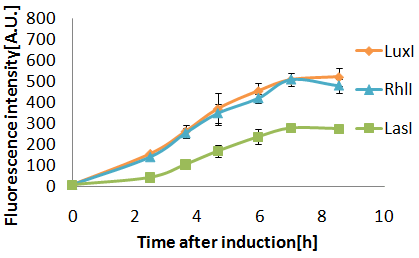
- 軸ラベル、直します。
- RhlIとLuxIでは、GFP inductionにかかる時間はほとんど同じであった.
- LasIは、GFP inductionが他より約2時間遅れた.
(冨永)
more about Sender experiment and result
Signal Molecule Receiver
English:
日本語:AHLを合成するSenderだけではなく、AHLを受け取る側のReceiverを変えれば、その応答時間を変えることができる。そこで私たちは、以下のいくつかの方法を考えた。
- 一種類のSender(AHL<--LuxI)に対して、由来生物の異なるレシーバタンパク質でそれを受信する.
- レシーバータンパク質であるLuxRに変異を入れることで、AHLに対する応答感度を上下させること.
- レシーバーのコピーナンバーを変える.
(福冨、小林)
Quorum-Sensing Crosstalkレシーバーたんぱくを変えて、クロストークを起こさせる |
Plasmid Copynumberレシーバーの遺伝子回路を含むプラスミドのコピーナンバーを変えることで、応答までの時間を変える |
LuxR mutantレシーバータンパク質であるLuxRに変異を入れることで応答感度を上下させる |
Signal Molecule Quencher
AiiAによるAHL分解を同時に起こすことで、AHL供給速度を遅くする.
- AHL reporter with aiiA
- Express LuxR and aiiA constantly. AiiA degrades AHL as signaling molecule. Express GFP when the AHL concentration exceed the capacity of aiiA.
- This enables the delay of the activation time of receiver.
AiiA experiments detail
Demo Experiments
実験内容とdataかるく
Demo experiments detail
English:
日本語:
シグナルを受け取るレシーバーを変える(クロストークの利用),シグナル自体を分解するAiia を利用する、レシーバーの遺伝子回路を含むプラスミドのコピーナンバーの変化、そしてレシーバータンパク質であるLuxRに変異を入れることによりreceiverのGFPの発現までにずれが生じるはず。
それを目視で確認しよう!
・確認の仕方
37℃で培養しているreceiverに時間(30min?)ごとにUVをあててGFPが見えるかチェックする。
香取
Conclusion
けつろん
Future Work
references
- [http://www3.interscience.wiley.com/journal/119124142/abstract M.K Winson et al.:Construction and analysis of luxCDABE-based plasmid sensors for investigating N-acyl homoserine lactone-mediated quorum sensing.FEMS Microbiology Letters 163 (1998) 185-192]
- [http://partsregistry.org/Part:BBa_F2620:Specificity BBa_F2620:Specificity]
- [http://authors.library.caltech.edu/5553/ C. H. Collins.et al.:Directed evolution of Vibrio fischeri LuxR for increased sensitivity to a broad spectrum of acyl-homoserine lactones.Mol.Microbiol.2005.55(3).712–723]
- [http://mic.sgmjournals.org/cgi/content/abstract/151/11/3589 B. Koch. et al.:The LuxR receptor: the sites of interaction with quorum-sensing signals and inhibitors.Microbiology 151 (2005),3589-3602]
| Home | The Team | The Project | Parts Submitted to the Registry | Reference | Notebook | Acknowledgements |
|---|
 "
"

